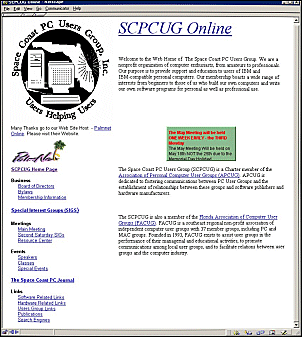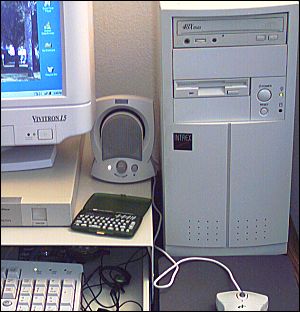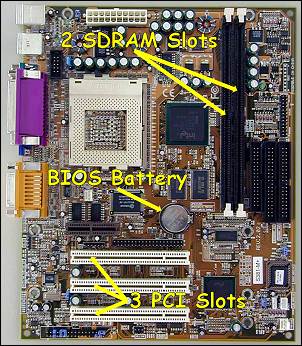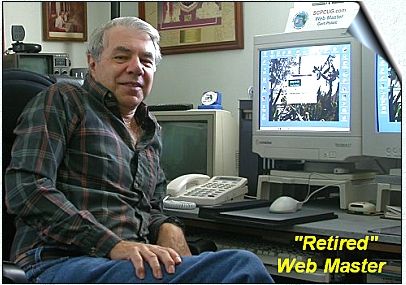|
By now many of you know that I decided to hang up my SCPCUG
Web Master hat. I was first elected SCPCUG Web Master in April
1998. After five years it is my good fortune that Catherine
Hall came along and is willing to take on this  demanding job. It is also
with some pride I look back on these past five years and realize
what a web site I have built! When I first took on the job of
Web Master the site was essentially in black and white with very
few graphics and even less photos. It numbered around 31 pages.
We now have over 78 pages. At the right is the SCPCUG Home
page from April 29, 1998. We did not have our own domain
then and PalmNet was providing us web hosting. demanding job. It is also
with some pride I look back on these past five years and realize
what a web site I have built! When I first took on the job of
Web Master the site was essentially in black and white with very
few graphics and even less photos. It numbered around 31 pages.
We now have over 78 pages. At the right is the SCPCUG Home
page from April 29, 1998. We did not have our own domain
then and PalmNet was providing us web hosting.
My past Web Master Wanderings columns have covered a variety
of subjects and for the most part were based on whatever new
program I was trying out, computing problem I was having, or
simply whatever interested me at the moment. My philosophy has
always been to help share my knowledge and experience in the
hope that it would help others. Guess that gets back to the SCPCUG
logo saying of "Users Helping Users."
Although I am leaving the Web Master position, I plan to continue
being listed under Helplines in the Space Coast PC Journal and
will be available to help members with their Internet/HTML and
Windows 98/ME questions. Speaking from personal knowledge I know
that computers at times can be quite unfriendly. I am happy to
have helped many members over the years. It is very satisfying
to know I have in some small way contributed to the successful
solution of another's computing problem. I am by no means an
expert. Many times I did not have the proper knowledge to solve
the problem but the SCPCUG has many members with knowledge in
different areas of interest. By knowing of the experience and
knowledge of other members I could usually point an individual
with a problem in the proper direction for an answer. That in
itself is a valuable benefit of membership.
So enough reminiscing. In this my last Web Master Wanderings
column I want to share more of my computing experiences and personal
opinions with the hope of helping you the reader gain more computing
insight.
Last year my daughter Jill gave me an old 466 MHz Celeron
computer with 17 inch ViewSonic monitor (pictured here with a
15 inch monitor) as a birthday present.  To me this was the
perfect present. It gave me a great learning tool. I could experiment
all I wanted without the fear of messing up important data or
programs. At the time, the company she was working for had been
caught in the economy crunch. They were rapidly downsizing and
consolidating. As a result, they were selling off some of their
assets to employees at bargain basement prices. So this is how
I acquired this micro tower computer with 128 MB PC66 SDRAM,
3 PCI slots (one filled by a network card), no AGP slot, 10 GB
hard drive, 48x CD-ROM drive, floppy drive, no sound card, and
no modem card. It had mini jacks on the back below the USB
ports for Spkr, Mic, and Line-In, but when
I went to Control Panel I found everything for audio grayed
out. Windows 95B (OSR2) was installed which negated use
of the USB ports. It looked to me like a prime candidate
for upgrading, although with only one empty 5.25 inch front panel
bay and only two empty PCI slots on the back, new component expansion
would be somewhat limited. To me this was the
perfect present. It gave me a great learning tool. I could experiment
all I wanted without the fear of messing up important data or
programs. At the time, the company she was working for had been
caught in the economy crunch. They were rapidly downsizing and
consolidating. As a result, they were selling off some of their
assets to employees at bargain basement prices. So this is how
I acquired this micro tower computer with 128 MB PC66 SDRAM,
3 PCI slots (one filled by a network card), no AGP slot, 10 GB
hard drive, 48x CD-ROM drive, floppy drive, no sound card, and
no modem card. It had mini jacks on the back below the USB
ports for Spkr, Mic, and Line-In, but when
I went to Control Panel I found everything for audio grayed
out. Windows 95B (OSR2) was installed which negated use
of the USB ports. It looked to me like a prime candidate
for upgrading, although with only one empty 5.25 inch front panel
bay and only two empty PCI slots on the back, new component expansion
would be somewhat limited.
Since this computer had been used in an industrial environment
it also contained several (unknown to me) industrial programs.
Overall, I was now presented with a great opportunity to use
a few computer skills and acquire new knowledge at the same time.
I had never built a computer from scratch and this computer came
with no documentation. Therefore, I was at a loss to know exactly
what I was dealing with at the technical level. And so the challenge
began...
The first thing I did was open the case in an effort to get
motherboard information. This in itself became my first challenge.
The case was sealed with a special screw and several stickers
which if broken voided the service warranty. The warranty part
was of no concern as it was already invalid due to the computer's
sale. But the screw removal was a problem. I was forced to drill
it out while paying careful attention not to get any metal shavings
inside the case (potential for a future short circuit).
Upon removing the case all I found on the motherboard was
a model number (S381-M+) but no name. Armed with this information
I went to the Internet and looked up the name of the  company that had assembled and sold
the computer for industrial use. There I found a listing of the
various computer configurations they lease and supply to industrial
companies. By matching the model number I was able to find that
Tekram made the motherboard. (Just that feat would have been
next to impossible before the age of the Internet.) Going to
the Tekram web site (http://www.tekram.com)
I was able to download the Installation Guide and the
BIOS, Driver & Utility Guide. All the motherboard
driver files and various motherboard utility programs were also
available for download. SCPCUG First Vice President and resident
GURU David Nottingham was kind enough to endure a 334
MB Tekram download and burn a CD-ROM for me with all the info
I would need. (Dave's on Broadband and I'm on Dial-Up.) I found
the motherboard had been made in 1999 and was no longer being
sold. It has Audio Codec 97 (AC97) sound on board and
the video is also integrated on the motherboard. Due to my lack
of knowledge it took me a while (again through Internet research)
to find out that the AC97 integrated sound did not work
because the computer was running Windows 95. AC97
sound provides a way for manufacturers to reduce computer costs
by eliminating the need to include a separate sound card. It
did not come into existence until 1998 (after Windows 95). company that had assembled and sold
the computer for industrial use. There I found a listing of the
various computer configurations they lease and supply to industrial
companies. By matching the model number I was able to find that
Tekram made the motherboard. (Just that feat would have been
next to impossible before the age of the Internet.) Going to
the Tekram web site (http://www.tekram.com)
I was able to download the Installation Guide and the
BIOS, Driver & Utility Guide. All the motherboard
driver files and various motherboard utility programs were also
available for download. SCPCUG First Vice President and resident
GURU David Nottingham was kind enough to endure a 334
MB Tekram download and burn a CD-ROM for me with all the info
I would need. (Dave's on Broadband and I'm on Dial-Up.) I found
the motherboard had been made in 1999 and was no longer being
sold. It has Audio Codec 97 (AC97) sound on board and
the video is also integrated on the motherboard. Due to my lack
of knowledge it took me a while (again through Internet research)
to find out that the AC97 integrated sound did not work
because the computer was running Windows 95. AC97
sound provides a way for manufacturers to reduce computer costs
by eliminating the need to include a separate sound card. It
did not come into existence until 1998 (after Windows 95).
Another challenge that presented itself was getting the Celeron
computer to talk to my other computers. Again, I relied on the
Internet to find the network card manufacturer Encore
(http://www.encore-usa.com)
and download the latest drivers and associated information. But
even with that I could not get networking up and running. I played
for a week configuring the network card. Finally, I called on
my son Chris who has much networking expertise. After several
hours he had it working. The secret was to completely remove
and reinstall the card and then reinstall all the drivers. Even
with that I was now getting three files that Windows could
not find on boot-up. They appeared to have something to
do with NetWare which may have been the previous protocol
used in the industrial environment. I solved that problem by
finding the answer on the Internet in the Microsoft
Knowledge Base (http://support.microsoft.com/).
I had to add and then remove Microsoft Client for NetWare
Networks which cured the problem. Apparently Windows
had been telling me that something still on the machine in the
Registry or the System.ini file was referring to
a device file which was removed when we removed the card.
Continuing on, I now had two choices. Either add a sound card
or upgrade Windows. I decided to upgrade rather than fill
another PCI slot since they were in short supply. Also I wanted
USB capability which required an upgrade. Now do I delete
everything and do a complete install from a clean drive or do
I upgrade from Win95B. I decided on the latter as I felt
I would learn more by first trying to remove these industrial
programs. So back to the Internet I went, researching file names,
to try to figure out what these programs actually did and maybe
get some idea of what files needed to be removed. I found some
of the programs were no longer being sold and any information
at best was very sketchy. A free (for personal use) program that
came in very handy in telling me exactly what programs were installed
on my machine was the Belarc Advisor (http://www.belarc.com/).
Belarc Advisor has been a link for quite a while under Computing
Help on our SCPCUG General Information Links page (http://www.scpcug.com/infolink.html).
Norton CleanSweep (now part of Symantec's Norton SystemWorks
at http://www.symantec.com/sabu/sysworks/basic/)
also proved most helpful in analyzing the installed programs
and helping me remove as many as possible. My problem was that
some of the programs were not listed in Control Panel's Add/Remove
Programs list. My intent was to get the hard drive as clean
as possible without removing the Windows 95 Operating System.
Before upgrading I cleaned the Registry using Norton CleanSweep
and then ran ScanDisk and Disk Defragmenter.
I was now ready to upgrade but for safety sake decided to
backup what remained on the 10 GB hard drive to my Gateway computer
via the network connection and then burned the data on to a CD-ROM.
The upgrade to Windows 98SE went smooth as could be. After
that I activated the USB ports in the BIOS and
installed the Win98SE sound drivers downloaded from the
motherboard manufacturer. My Celeron computer came alive! I finally
had sound! I temporarily used an old stereo receiver's amplifier
and speakers until I came across a great deal from Staples and
got a $40 Altec Lansing AVS300 3-piece speaker set (two satellites
and a woofer) for $10 after rebates. At the same time (also from
Staples) I got a 56K V.92 voice/fax modem for free after rebates.
Who said you can't outfit a computer cheap?
I had no prior experience with AC97 sound and had always
heard if you wanted the best sound for MIDI, get a soundcard
with WaveTable Sampled Sound. To my surprise this AC97
sound relies on a software version of Roland Sound Canvas digital
samples. Granted it does not compare to the MIDI sound from the
SoundBlaster Live card in my 1 GHz ABS Technologies computer
but it is decent enough for a someone not an audiophile.
Another surprise came when I tried to convert the 10 GB drive
to FAT32. The Drive Converter program in Win98SE
told me the drive was already formatted for FAT32. I had
thought FAT32 came into existence with Win98 but
it must have been with Win95B.
Moving right along, I next added a second hard drive. I had
a used 3 GB hard drive sitting on the shelf for several years.
It had been removed from my old Gateway computer when I upgraded
that computer's second drive to a 8 GB hard drive. So I decided
to put it to good use. I soon discovered that working in the
cramped quarters of a micro sized case is a real challenge. A
second hard drive had to sit vertically on edge behind the lower
front panel and be stacked parallel to the original hard drive
in its internal drive bay. Once installed, there were no internal
bays left. On the front, the top bay is used by the 48X CD-ROM
drive and a second bay below it is empty but hard to get to because
of the top bay being occupied. If I were to add a CD-RW drive
I would be out of room there also. Such is the limited expansion
capability of these micro sized cases. This is a very important
consideration when buying a new computer as many new computers
you see in the stores use a micro size case. Sure it looks good
because it's small. But working on it is difficult and consideration
must be given as to what future components might be added.
All was going well when I noticed that the clock in the System
Tray on my DeskTop was losing time. That is usually
a sign that the BIOS battery on the motherboard needs
replacing. Mine was a very common type, a 3 volt Lithium disk
type model CR2032. I had always heard since my Windows 95
days that before changing the BIOS battery be sure to
write down all your BIOS settings so as not to lose them.
So I dutifully used my Sony Camcorder and the video capture card
in my ABS Technologies computer to take 21 photos of the BIOS
screens. After I changed the battery I went back into the BIOS
and was pleasantly surprised to find all the settings were identical
to what I had before. I knew for a fact that these were not the
factory default settings because I had made some changes. At
first I thought maybe motherboard design had improved and a circuit
added to keep the settings during the minute it takes to change
the battery. However, a PC Mechanic article on CMOS Backup
Battery at http://www.pcmech.com/show/motherboards/80/
states "If you're really fast, you may be able to replace
the battery and not lose any settings. There will be a residual
charge left in the CMOS that MAY hold the data for a few minutes."
But they still recommended having a backup of your settings.
Anyway my clock now keeps good time and periodically I sync it
for perfect time using the NIST Internet Time Service
(http://www.boulder.nist.gov/timefreq/service/its.htm),
another link on our SCPCUG General Information Links page under
the Reference section.
Never being one to stop tweaking, I next partitioned the computer's
original 10 GB hard drive into seven partitions using PowerQuest's
Partition Magic (http://www.powerquest.com/).
I had grown used to the segregation that partitioning allows
with my Gateway computer and decided to do the same for this
Celeron computer. I did have one moment of "panic"
in the partitioning process. After instructing Partition Magic
as to how the hard drive was to be partitioned it is necessary
for the computer to shutdown and reboot. The magic is performed
during the boot-up. Well on shutdown the computer
hung. The screen was frozen and the mouse would not work. I had
to go to the 3-finger salute (Control+Alt+Delete
keys pressed at the same time) to get it to shutdown.
I was now not sure if it would remember the partitioning instructions
given it before shutdown. I wondered if I would have a
working computer on boot-up because normally with an improper
shutdown, Windows 98SE wants to run ScanDisk
on boot-up. How that played into the equation was an unknown.
As it turned out, all went well. Partition Magic did its magic
in DOS first, and when Windows finally booted I
had a nicely partitioned drive.
 Such
are the adventures one encounters in computing. Such
are the adventures one encounters in computing.
I leave you now with this one last photo recently taken by
SCPCUG Club Photographer Robin Mills. After writing
more than three dozen Web Master Wanderings articles over the
past five years it is "time for a change." Our new
Web Master Catherine Hall has graciously agreed to continue
Web Master Wanderings. I am most eager to see what Catherine
will write about and will certainly enjoy getting a woman's perspective
on this computing world. Bye!
Note: Web Master Wanderings
articles contain links to external web sites. Web addresses are
constantly changing. There is no guarantee that the information
links provided in this article will remain unbroken or up-to-date
beyond the date that this article is originally published. |